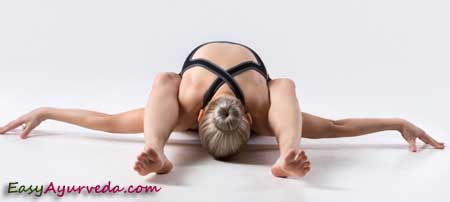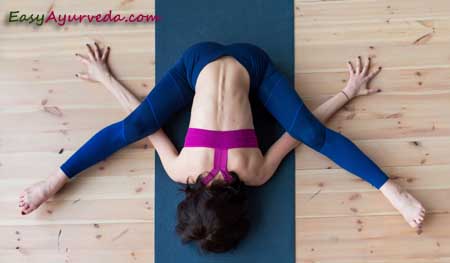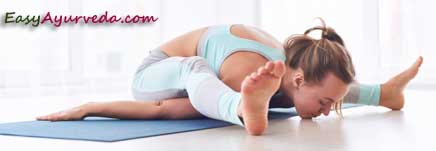Kurmasana – Tortoise Pose Or Turtle Pose, How to do, Benefits, Ayurveda Details
Article by Dr Raghuram Y.S. MD (Ay) & Dr Manasa, B.A.M.S
Kurmasana is an asana in which the person performing the asana needs to take the pose of a tortoise or turtle. Therefore the asana is named as Kurma Asana or Koorma Asana i.e. Tortoise Pose.
Table of Contents
Word meaning
Kurmasana (Koormasana) – Tortoise Pose or Turtle Pose
Meaning –
Kurma / Koorma = Tortoise / Turtle
Asana = Pose, Posture
Kurmasana is an asana in which the person performing the asana needs to take the pose of atortoise or turtle. Therefore the asana is named as Kurma Asana or Koorma Asana i.e. Tortoise Pose.
Preparation for Kurmasana
- Kurmasana yields optimum benefits if it is practiced early in the morning. The best time for practicing Kurmasana is the Brahmi Muhurta i.e. about 1 and half hour before the sunrise. At this fresh hour, the mind is inherently calm, settled and at peace. This makes easier for you to draw inwards into your mind and body and surrender to self. Kurmasana can alternatively be practiced in the evenings also, since it is difficult to get up daily at Brahmi Muhurta. But when done in evening it is difficult to cut off your mind from the material world, to embark an inward journey and have that rare experience of knowing yourself.
- Kurmasana shall be practiced on empty stomach. Care should be taken to keep your bowel and bladder empty while practicing this asana. Food shall be taken at least 4-6 hours before commencing this asana.
Method
Method of doing Kurmasana
Positioning for the Asana
- Sit in Dandasana, with your back erect and your legs spread out in front of you such that your torso forms a 90 degree angle with your spread out lower limbs.
- Place your arms by the side of your hips.
- Place your legs (lower limbs) at arms distance apart from each other.
- Press your thighs into the ground.
- Raise your chest.
- Take few deep breaths.

Performing and getting to the Kurmasana
- After positioning yourself on the ground, spread your legs while bending your knees and bring your thighs close to your body and calves closer to the inner part of your thighs. Now your legs have formed an acute angle with your thighs. At this position soles of your feet are resting on the ground. The feet are almost closer to your hips.
- Bend your torso down and forward slowly along with your arms, in between your spread out legs. While bending your torso, slide your arms (upper limbs) beneath your flexed legs (lower limbs) such that your right arm goes beneath your right flexed knee (angle formed between your right thigh and leg) and your left arm slides beneath your left flexed knee (angle formed between your left thigh and leg).
- Bend your knees further so as to facilitate your shoulders to go beneath your knees.
- Now shift your stretched arms to the sides, beneath your legs.
- As your arms are stretched and spread out beneath your legs, bring your thighs inwards while walking on your foot inwards, towards the midline or median plane of your body. This will facilitate the arms to move further in, beneath the lower limbs.
- Once the shoulders go beneath your knees, bring down your knees towards the floor as much as possible (reducing the angle between your thighs and legs) and pressing over your shoulders.
- Bring your face and chest slowly forward and down, towards the floor.
- Straighten your legs while they press on your shoulders. Now you can feel your inner thighs touching your side ribs.
- Gradually bring down your head with your chin touching the ground and gaze downwards.
- Extend your arms side wards (beneath your lower limbs) as much as possible. Now your upper limbs beneath your lower limbs, which are extended side wards, form an approximate right angle with your straightened legs.
- Relax and breathe easily and deeply.
Release from the asana and coming back to the point of start
- Be in this pose for few seconds. Take deep breaths.
- Slowly release your extended arms and pull them in, gradually from beneath your lower limbs (knees).
- Lift your upper limbs and bring them alongside your hips as you had kept them at the beginning of the pose.
- Stretch and straighten your lower limbs as you bring them closer to each other.
- Come back to the staff pose and relax.
Tips for beginners –
Kurmasana is an advanced pose. It takes a lot of time and practice to do it appropriately. It is not an easy job to do this asana. It is an art by itself, a tough one and challenging one too. You need to do it under the proper guidance of an expert Yoga tutor so that you get the asana right and good.
Once in the pose, you may find it extremely difficult and painful to place the heels of your feet grounded. In this case keep pillows or folded blankets beneath your legs.
Advanced pose
Advanced pose (variation of Kurmasana)
- If it is difficult to perform Kurmasana, you can try doing its variant i.e. Ardha Kurmasana (Half Tortoise Pose).
- If you can do Kurmasana comfortably, you can try to extend it to Supta Kurmasana (Sleeping Tortoise Pose), which is a deeper pose of Kurmasana.

Purva and Paschat Asanas
Purva Asanas (Preparatory Asanas)
Before Kurmasana, you can do one or more of the below mentioned Asanas –
- Uttanasana
- Paschimottasana
- Dhanurasana
Paschat Asanas (Post-Kurmasana Poses)
After performing Kurmasana, one can perform –
- Bhujangasana
- Matsyasana
- Chakrasana
Duration, health benefits
What time should be spent in the pose while doing Kurmasana?
One can stay in Kurmasana for 30 seconds to 60 seconds at a stretch.
Health Benefits of Kurmasana
Below mentioned are the benefits of Kurmasana –
- Kurmasana lengthens your spine.
- It relaxes your head, neck and shoulders.
- Kurmasana is an effective remedy for all back disorders.
- The asana releases the tight knots in the lumbar and sacral regions of your body.
- The asana effectively opens up your shoulders and strengthens them.
- Kurmasana improves your posture. It is good for those who are suffering from cervical disorders.
- It makes your body flexible and toned.
- Kurmasana helps in improvising the functions of respiratory and digestive functions.
- Kurmasana helps in easy breathing. It is a good cure for asthma.
- Kurmasana stimulates your abdominal organs.
- Kurmasana provides relief from constipation and eases flatulence.
- This asana is good for calming the nerves and a cure for insomnia.
- Kurmasana improves circulation to the brain and helps in improving your memory.
- The asana is one of the best stress busters. It helps you to withdraw your senses and keep peace with self.
- It calms your mind, and prepares you for meditation.
- Kurmasana refreshes and rejuvenates you.

Kurmasana – Ayurveda Perspective:
Effect on Doshas
Effect of Kurmasana on Doshas and Subtypes
Kurmasana calms the vitiated Prana Vata and Udana Vayu. When the balance between these two subtypes of Vata is achieved through this asana, the breathing functions improve. This helps in curing respiratory problems like asthma and bronchitis.
The calmness of Prana Vayu achieved by Kurmasana helps in calming the nerves, helps beating the stress, soothes the mind, helps withdrawing self from the senses and worldly pleasures and keep peace with yourself. The asana also cures sleeplessness effectively. It removes stiffness from your neck, head and shoulders and relaxes these structures. It gives a stretch to these organs.
The asana by establishing coordination between these two Vayu subtypes helps in calming the mind and allows you to meditate, concentrate and focus. When the body and mind are calmed, you feel relaxed, refreshed and rejuvenated.
Koormasana stimulates Samana Vayu and Pachaka Pitta and helps in improving the digestive functions. It also stimulates the digestive organs.
Kurmasana has a balancing effect on the apana vayu. By doing so it cures constipation and flatulence. It also strengthens the lumbar and sacral vertebrae, relieves pain and catches therein.
Effect on Dhatus
Effect of Kurmasana on Dhatus –
Kurmasana strengthens and stretches the mamsa dhatu (muscle tissue), relaxes the snayus (ligaments) and kandaras (tendons) in the spine, head, neck, lower back and shoulders, relieves pain and stiffness from these regions and relaxes these structures. Kurmasana strengthens the asthi dhatu (bones) and stretches the spine.
Effect on Malas
Effect of Kurmasana on Malas –
Kurmasana helps in timely excretion of feces and urine by controlling and calming the apana vayu, relieves constipation, flatulence and urinary disorders.
Kurmasana, what it promises!
Kurmasana or the tortoise pose resembles a tortoise which withdraws itself into its shell when threatened or agitated. Regular practice of Kurmasana helps you to draw yourself inward and cut out the clutter of the outside world. It helps you to keep yourself withdrawn from the materialistic world and helps in knowing yourself. It gives you a rare experience and a euphoric feel of connecting yourself with your inner world.
If you need to rework and assess yourself and find your real self by making a journey inwards, you need a serene environment and an asana which cuts you off from the external world and also spend time in solitude. Kurmasana is one such asana which helps you in accomplishing it. This asana should be a mandatory part of your exercise regimen if you are looking for the above mentioned benefits. Kurmasana helps to monitor self regularly. This self check saves and protects you from many troubles and diseases.
Impact on Chakras
Kurmasana balances and calms Swadishtana Chakra or Sacral Chakra and Manipura Chakra or Solar Plexus. Swadishtana Chakra when balanced helps us maintain relationships. It helps us to value selves and also others equally. This chakra also strengthens the reproductive system. It helps us to be artistic and induce creativity in us. When Kurmasana balances the Manipura Chakra, it helps us to identify and discover our identity. It gives us the power, control and ease with which we can be ourselves. The balanced Manipura Chakra helps in enhancing the metabolism and digestion capacity. We get rid of disorders caused due to sluggish metabolism.
Contraindications and precautions
Who should not do? (Contraindications and precautions for doing Kurmasana)
If you feel pain in the knees, move your arms slightly forward from the sides to ease the pain.
You must prepare your body for performing Kurmasana. To do this you should thorough yourself with preparatory poses.
You should know your comfort zone and your body limitations. You should also know when to stop.
You should not overstrain your muscles while doing or keeping yourself in this pose.
Patients suffering from below mentioned conditions should avoid doing Kurmasana –
- Herniated Discs in the back and severe back pain
- Tight lower back muscles
- Shoulder joint injury
- Hip joint injury
- Arm injury
- Sciatica
- Chronic Arthritis
Avoid Kurmasana while pregnancy and menstrual periods.
Just Before Finish
Kurmasana is one of the best asanas which gives a good physical workout and a comprehensive stress buster to the mind. Thus it is a wholesome pose which helps in establishing body-mind health, to discover self and to cure many ailments. In this article I have covered in depth about Kurmasana, the methods of doing it, indications and health benefits and contraindications.
Click to Consult Dr Raghuram Y.S. MD (Ayu) – Email / Skype









